英语介词用法详解
- 格式:doc
- 大小:40.00 KB
- 文档页数:4

40个英语介词用法总结40个英语介词用法总结1. in: 表示在某个地方或时间内,例如:in the park, in the morning2. on: 表示在某个表面或时间点上,例如:on the table, on Monday3. at: 表示在某个地点或时刻,例如:at the cinema, at 9 o'clock4. by: 表示通过某种方式或在某个时间之前,例如:by car, by tomorrow5. for: 表示为了某个目的或一段时间,例如:for a party, for a week6. with: 表示伴随或使用某物,例如:with friends, with a pen7. to: 表示移动到某个地方或给予某人,例如:go to school, give it to me8. from: 表示起始点或来源,例如:from home, from China9. into: 表示进入某个地点或状态的转变,例如:jump into the water, turn into a butterfly10. out: 表示从某地点离开或移动到室外,例如:go out, look out of the window11. up: 表示向上移动或增加,例如:climb up the stairs,wake up12. down: 表示向下移动或减少,例如:walk down the hill, calm down13. about: 表示关于某事或在某个范围内,例如:talk about the movie, wander about the city14. off: 表示离开或关闭,例如:get off the bus, turnoff the lights15. on: 表示打开或激活,例如:turn on the TV, switch on the computer16. over: 表示越过或在某地上方,例如:jump over the fence, fly over the city17. under: 表示在某物下面或被控制或影响,例如:hide under the bed, live under his rules18. with: 表示具有某种特征或和某人一起做某事,例如:a man with blue eyes, dance with me19. without: 表示没有某物或在缺乏某物的情况下,例如:go without food, live without regret20. by: 表示通过某种方式,例如:learn by doing, go by bus21. through: 表示穿过某物或完成某事,例如:walk through the door, go through the documents22. across: 表示横穿某物或在某个范围内,例如:swimacross the river, all across the world23. between: 表示在两个事物之间或在某个时间段,例如:choose between two options, between 9 and 10 o'clock24. among: 表示在三个或三个以上事物之间或在某群人中,例如:share among friends, discuss among colleagues25. around: 表示在周围或在某个时间点附近,例如:walk around the park, around midnight26. through: 表示通过某事物或在某段时间内,例如:read through the book, work through the night27. against: 表示反对或靠在某物上,例如:fight against injustice, lean against the wall28. for: 表示代表或支持某人或某事,例如:vote for a candidate, fight for freedom29. towards: 表示朝向某个方向或对某人有好感,例如:walk towards the beach, feel towards someone30. within: 表示在某个时间或范围内,例如:arrive within an hour, within the city limits31. beyond: 表示超出某个界限或超过某个程度,例如:beyond expectations, beyond the horizon32. along: 表示沿着某个路线或伴随某人一起,例如:walk along the street, sing along with the song33. above: 表示在某物之上或高于某个程度,例如:flyabove the clouds, above average34. below: 表示在某物之下或低于某个程度,例如:swim below the surface, below freezing35. beside: 表示在某物旁边或和某人一起,例如:sit beside me, beside the lake36. near: 表示在某物附近或接近某个时间,例如:live near the beach, near the end37. past: 表示经过某个地点或在某个时间之后,例如:walk past the store, past midnight38. around: 表示在周围或大约某个数量,例如:look around the room, around 20 people39. after: 表示在某个时间之后或追求某人或某事,例如:after dinner, run after the dog40. before: 表示在某个时间之前或在某个事件之前,例如:before sunrise, before the meeting这些介词是英语中常用的一些基本介词,它们在表达地点、时间、方式等方面起到了重要的作用。

介词英语的用法总结介词英语的用法总结一、介词在英语中是一种重要的词,起连接词语之间的作用,连接它们表达语义;1. 介词“of”:表示所有格、归属等意思。
如:the cover of the book(这本书的封面)2. 介词“for”:表示目的、原因、对象等意思。
如:I'm here for you(我在这里是为了你)3. 介词“in”:表示在……中、在……时间段、里面等意思。
如:in the morning(在早上)4. 介词“on”:表示在某个表面、在某一天上等意思。
如:on Monday(星期一)5. 介词“at”:表示在某一地点、在某一时刻等意思。
如:at night (在晚上)6. 介词“by”:表示由……完成、靠近、在……旁边等意思。
如:by foot(步行)7. 介词“from”:表示从某一地方出发、来自……等意思。
如:from home(从家出发)8. 介词“with”:表示和……相关、用……做某事等意思。
如:with a pencil(用铅笔)9. 介词“to”:表示朝向某一处、前往等意思。
如:to school (上学)10.介词“for”:表示为了……、把……作为等意思。
如:for fun (为了好玩)11.介词“as”:表示作为、当……时等意思。
如:as a teacher (作为一个老师)12.介词“over”:表示在……上、穿过等意思。
如:over the bridge (过桥)13.介词“since”:表示从……起、既然等意思。
如:since then (从那时起)14.介词“into”:表示到……里面、转向等意思。
如:into the room(进房间)二、最后,需要强调的是,介词的使用要灵活搭配,以正确表达出英语句子的意思,以便达到更好的英语表达效果。
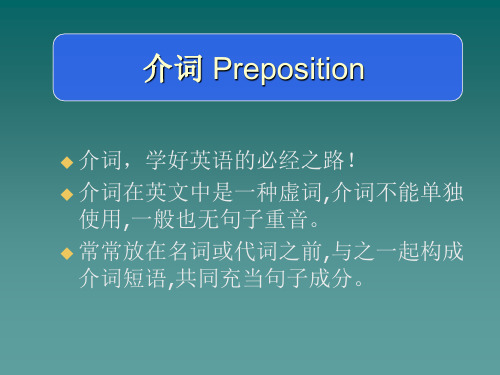

英语介词用法详解英语介词是连接词与词之间关系的重要语法成分,它们用于表示空间、时间、关系等概念。
正确的使用介词是英语学习的基础之一。
本文将详细介绍英语介词的常见用法。
一、表示方向和位置的介词1. In(在):用于大的地点范围之内,表示“在……里面”。
- There is a book on the desk.- I live in New York.2. On(在、在上、在……上面):用于平面、表面或边界之上。
- The cat is on the table.- The painting hangs on the wall.3. At(在、在……附近):用于特定的地点或位置。
- I met him at the park.- We will meet at the restaurant.4. Under(在……下面):表示相对高度或遮挡。
- The cat is under the table.- He found his keys under the sofa.5. Behind(在……后面):表示在某物后面。
- The car is parked behind the house.- She is hiding behind the tree.6. Beside(在……旁边):表示在某物的旁边。
- My house is beside the park.- She sat beside her friends.7. Inside(在……里面):表示在某物的内部。
- The wallet is inside the bag.- There is a surprise inside the box.8. Outside(在……外面):表示在某物的外部。
- The children are playing outside the house.- Don't forget to lock the door when you go outside.二、表示时间的介词1. On(在某天):用于特定的日期。

史上超全的英语介词用法归纳总结!不看太可惜了英语介词是一种非常重要的语法成分,用于表示名词与其他句子成分之间的关系。
以下是史上超全的英语介词用法归纳总结:1.基本介词:- in:在...内部- on:在...表面- at:在...位置或时间点- by:通过其中一种方式- with:用物- from:从...来- to:到...去- for:为了- of:属于...的2.时间介词:- in:用于特定时间段,如in the morning(在早上)- on:用于特定日期或星期,如on Monday(在星期一)- at:用于具体时间点,如at 3 o'clock(在3点钟)3.地点介词:- in:用于大的地理范围,如in China(在中国)- on:用于较小的地理范围或表面,如on the street(在街上)- at:用于具体地点,如at the supermarket(在超市)4.方向介词:- to:表示到达一些地方,如go to school(去学校)- into:表示进入一些地方,如go into the house(进入房子)- out of:表示离开一些地方,如get out of the car(离开车)5.原因介词:- because of:由于,如He is late because of the traffic(他因为交通堵塞而迟到)- due to:由于,如The flight was canceled due to bad weather(因为恶劣天气,航班被取消)6.动词短语介词:- look after:照顾,如She looks after her younger brother (她照顾她的弟弟)- take care of:照顾,如He takes care of his plants(他照顾他的植物)7.形容词短语介词:- interested in:对...感兴趣,如She is interested in music (她对音乐感兴趣)- good at:擅长...,如He is good at playing basketball(他擅长打篮球)8.其他常见介词用法:- with regard to:关于,如With regard to the matter, I have something to say(关于这件事,我有些话要说)- instead of:代替,如I will go instead of him(我将代替他去)- according to:根据,如According to the weather forecast, it will rain tomorrow(根据天气预报,明天会下雨)以上是一些常见的英语介词用法总结,希望能帮到你!。
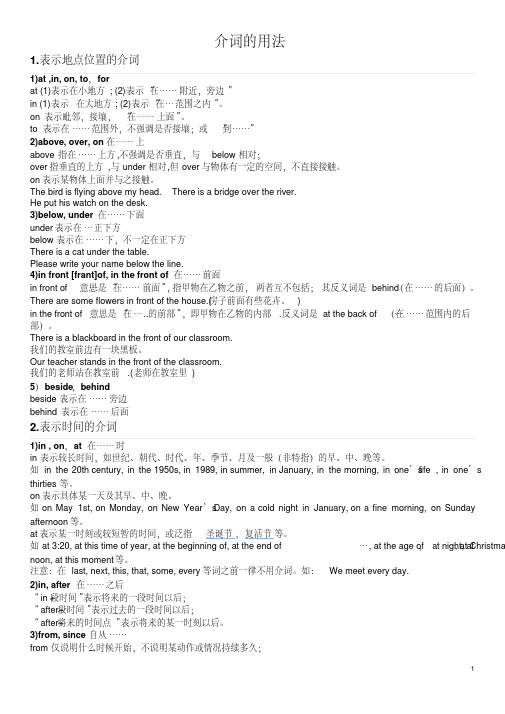
介词的用法1.表示地点位置的介词1)at ,in, on, to,forat (1)表示在小地方; (2)表示“在……附近,旁边”in (1)表示在大地方; (2)表示“在…范围之内”。
on 表示毗邻,接壤,“在……上面”。
to 表示在……范围外,不强调是否接壤;或“到……”2)above, over, on 在……上above 指在……上方,不强调是否垂直,与below相对;over指垂直的上方,与under相对,但over与物体有一定的空间,不直接接触。
on表示某物体上面并与之接触。
The bird is flying above my head. There is a bridge over the river.He put his watch on the desk.3)below, under 在……下面under表示在…正下方below表示在……下,不一定在正下方There is a cat under the table.Please write your name below the line.4)in front [frant]of, in the front of在……前面意思是“在……前面”,指甲物在乙物之前,两者互不包括;其反义词是behind(在……的后面)。
in front of…There are some flowers in front of the house.(房子前面有些花卉。
)in the front of 意思是“在…..的前部”,即甲物在乙物的内部.反义词是at the back of…(在……范围内的后部)。
There is a blackboard in the front of our classroom.我们的教室前边有一块黑板。
Our teacher stands in the front of the classroom.我们的老师站在教室前.(老师在教室里)5)beside,behindbeside 表示在……旁边behind 表示在……后面2.表示时间的介词1)in , on,at 在……时in表示较长时间,如世纪、朝代、时代、年、季节、月及一般(非特指)的早、中、晚等。
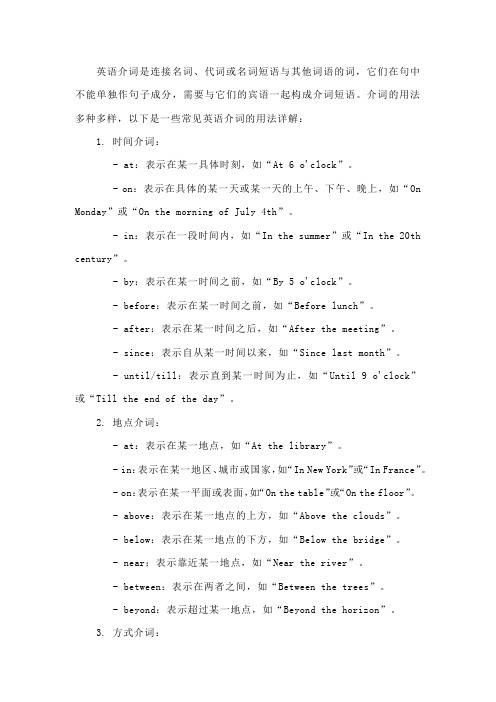
英语介词是连接名词、代词或名词短语与其他词语的词,它们在句中不能单独作句子成分,需要与它们的宾语一起构成介词短语。
介词的用法多种多样,以下是一些常见英语介词的用法详解:1. 时间介词:- at:表示在某一具体时刻,如“At 6 o'clock”。
- on:表示在具体的某一天或某一天的上午、下午、晚上,如“On Monday”或“On the morning of July 4th”。
- in:表示在一段时间内,如“In the summer”或“In the 20th century”。
- by:表示在某一时间之前,如“By 5 o'clock”。
- before:表示在某一时间之前,如“Before lunch”。
- after:表示在某一时间之后,如“After the meeting”。
- since:表示自从某一时间以来,如“Since last month”。
- until/till:表示直到某一时间为止,如“Until 9 o'clock”或“Till the end of the day”。
2. 地点介词:- at:表示在某一地点,如“At the library”。
- in:表示在某一地区、城市或国家,如“In New York”或“In France”。
- on:表示在某一平面或表面,如“On the table”或“On the floor”。
- above:表示在某一地点的上方,如“Above the clouds”。
- below:表示在某一地点的下方,如“Below the bridge”。
- near:表示靠近某一地点,如“Near the river”。
- between:表示在两者之间,如“Between the trees”。
- beyond:表示超过某一地点,如“Beyond the horizon”。
3. 方式介词:- by:表示通过某种方式或手段,如“By car”或“By phone”。

介词的用法及应用场景介词是一种虚词,用于连接名词、代词、动词、形容词或副词与其他成分,表达它们之间的关系。
介词可以表示时间、地点、原因、目的、方式、手段等概念。
在语法上,介词通常放在名词或代词前面,构成介词短语。
介词的使用具有一定的规则,以下是一些常见的介词及其用法和应用场景。
1. 地点介词:地点介词用于表示人或物所处的位置或方向关系,常见的地点介词包括:- in: 表示在某个较大的范围内,比如in the room(在房间里)、in the city(在城市里)。
- on: 表示在某个表面上或靠近某个表面,比如on the table(在桌子上)、on the street(在街上)。
- at: 表示在某个位置或地点,比如at the park(在公园里)、at the bus stop (在公交车站)。
- by: 表示在某个物体或人旁边,比如by the river(在河边)、by the window (在窗边)。
- near: 表示在附近,比如near the supermarket(在超市附近)。
2. 时间介词:时间介词用于表示时间的关系,常见的时间介词包括:- in: 表示在未来某个时间段内,比如in a week(一周后)、in the morning(在早晨)。
- on: 表示在某个具体的日期或星期几,比如on Monday(星期一)、on July 4th (7月4日)。
- at: 表示在具体的某个时间点,比如at 2 o'clock(在2点钟)、at night(在晚上)。
- during: 表示在某个时间段内,比如during the summer(在夏天)、during the meeting(在会议期间)。
3. 原因和目的介词:原因介词用于表示某个动作或情况的原因,常见的原因介词包括:- because of: 表示由于某个原因,比如because of the rain(因为下雨)。
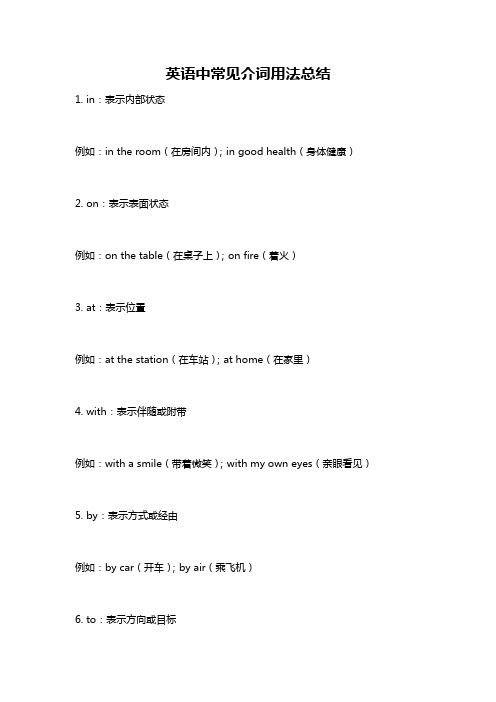
英语中常见介词用法总结
1. in:表示内部状态
例如:in the room(在房间内);in good health(身体健康)2. on:表示表面状态
例如:on the table(在桌子上);on fire(着火)
3. at:表示位置
例如:at the station(在车站);at home(在家里)
4. with:表示伴随或附带
例如:with a smile(带着微笑);with my own eyes(亲眼看见)5. by:表示方式或经由
例如:by car(开车);by air(乘飞机)
6. to:表示方向或目标
例如:to the park(去公园);to the moon(到月球)
7. from:表示出发地或来源
例如:from Beijing(来自北京);from the magazine(从杂志中)
8. for:表示目的或用途
例如:for a birthday party(为了生日派对);for writing(用于写作)
9. of:表示属于或关系
例如:the book of Harry Potter(哈利·波特的书);the sister of Mary(玛丽的姐姐)
10. with:表示具有或伴随
例如:a man with a gun(拿着枪的人);a girl with long hair(长发女孩)。

介词的用法一、表示时间日期的介词1.at:主要表示方向、场所、时间的某一点at the corner of the street,at dinner,at sixty miles an hour,be sold at three yuan a dozen,come at us固定搭配:at one time,at the beginning of,at the post office,at the airport,at the weekend,at the age of25,at the same time,at present,at any time,表示原因,表示“见/闻……而”。
at the news at主要表示时间点表示特定的时间at night a.m.在九点钟表示不确定的时间at night,at that time,at Christmas 在圣诞期间当天on表示年龄段at the age of eight在8岁2.in:表示场所、时间与期限、状况、方向。
主要用来表示较长的时间单位,如月份、季节、年份等in the1990s in the late19th century形成“in+时段名词”的词组或固定搭配in those days,in the daytime,in a short while,in no time,in time.in主要表示时间段一般指相对较长的时间段里in the morning,in spring,in the past ten years在…时间之后,用于将来时He will be back in a month.介词in在短语或句型中的省略:1)某些形容词/过去分词后接v-ing形式时,v-ing形式前的介词in可以省略。
be busy(in)doing be engaged(in)doing(忙于……)2)某些动词如busy等,常与反身代词连用,其后的in也可以省略。

英语语法:介词用法介词在英语语法当中是非常常用的一种语法结构,那么作为常用的语法我们该如何学好呢,下面就是小编给大家带来的英语语法:介词用法,希望能帮助到大家!介词的用法一:一、介词to的常见用法1.动词+toa)动词+ toadjust to适应,attend to处理;照料,agree to赞同,amount to加起来达…,belong to属于,come to达到,drink to为…干杯,get to到达,happen to发生在某人身上,hold to紧握,lead to通向,listen to听,occur to想起,object to反对,point to指向,respond to回答,refer to参考;指的是…;涉及,reply to回答,see to负责,stick to坚持,turn to求助,write to给某人写信。
b)动词(+sth.)+to+sb.announce to通知某人, describe to向某人描述, explain to 向某人解释, express to对某人表达, mention to提及, nod to向某人点头,report to报告,say to告知,shout to对某人大叫,suggest to对某人提建议,speak to与某人交谈,talk to跟某人谈话, whisper to和某人低声耳语。
c)动词+sth./sb.+ to +sth./sb.add to增加, compare to比作, carry to运送至, devote to 致力于,introduce to介绍给, invite to邀请参加, join to连接到,leave to委托给,reduce to下降至, sentence to判处, take to带到。
2. be +形容词/过去分词+ tobe alive to觉察;晓得,be attentive to注意;留心,be awake to知晓,be blind to缺乏眼光,be close to紧挨着,be common to对某人来说很普通,be contrary to违反;反对,be devoted to致力,be deaf to不愿意听,be equal to有…的力量,be exposed to暴露;遭受,be fair to对…公平,be familiar to对某人来说熟悉,be grateful to对某人心存感激,be good to对…有好处,be harmful to对…有危害,be important to对…重要,be kind to友好对待,be known to周知于,be married to嫁给,be moved to转移到,be near to靠近,be necessary to对…有必要,be opposite to在对面,be opposed to反对,be pleasant to合某人之意,be proper to专属,be polite to礼貌待人,be rude to粗暴对待,be relative to与…有关,be strange to不习惯,be similar to类似,be suitable to适合,be true to忠实,be thankful to感激,be useful to对…有用,be used to习惯。
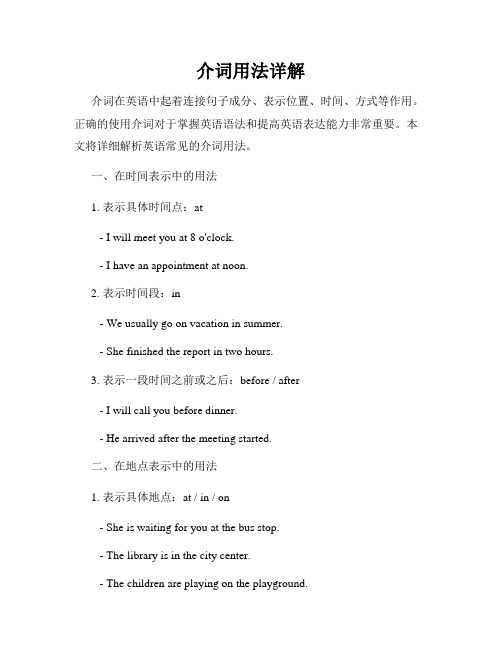
介词用法详解介词在英语中起着连接句子成分、表示位置、时间、方式等作用。
正确的使用介词对于掌握英语语法和提高英语表达能力非常重要。
本文将详细解析英语常见的介词用法。
一、在时间表示中的用法1. 表示具体时间点:at- I will meet you at 8 o'clock.- I have an appointment at noon.2. 表示时间段:in- We usually go on vacation in summer.- She finished the report in two hours.3. 表示一段时间之前或之后:before / after- I will call you before dinner.- He arrived after the meeting started.二、在地点表示中的用法1. 表示具体地点:at / in / on- She is waiting for you at the bus stop.- The library is in the city center.- The children are playing on the playground.2. 表示方向:to / towards- I walked to the park.- They ran towards the exit.三、在方式表示中的用法1. 表示方式和手段:by- We traveled to Beijing by train.- He sent the document by email.2. 表示交通工具:on / by- I go to work on foot.- She goes to school by bus.四、在原因和目的表示中的用法1. 表示原因:because of- The game was canceled because of the bad weather. - He couldn't attend the party because of his illness.2. 表示目的:for- I bought a gift for my friend's birthday.- We studied hard for the upcoming exam.五、在其他表示中的用法1. 表示关系:of- The book on the table is mine.- The color of the car is blue.2. 表示所属关系:of- The top of the mountain was covered in snow.- The tail of the dog was wagging happily.总结:介词在英语中有着不同的用法,包括时间、地点、方式、原因和目的等方面。

英语介词的用法归纳英语介词是连接词汇与词汇,短语与短语之间,在句子中起到连接作用的词类。
它们用来确定词与词、短语与短语之间的关系,并表示时间、空间、原因、目的、手段、方式等等。
英语语法中常见的介词有约40多个,下面将对常见的英语介词进行归纳总结,以供参考。
一、表示时间的介词:1. at:表示具体的时间点,通常与表示时间的名词连用;也可表示某些特定的固定日、节日或场所。
例句:at 6 o'clock, at sunrise, at school2. in:表示较长的时间段、季节、月份、年、部门和地方等。
例句:in summer, in 2019, in London3. on:表示具体的某一天或某一天的上午/下午/晚上等。
例句:on Monday, on the morning of May 1st4. by:表示“最晚”、“到”的意思,通常表示某个时间点之前。
例句:by 10 o'clock, by the end of the year5. for:表示持续的时间段,通常与表示时间的名词连用。
例句:for three hours, for a week二、表示空间的介词:1. in:表示在某个或某些三维空间范围之内,也可表示在某个具体的区域或地点。
例句:in the room, in the park2. on:表示在某个平面面上,通常用来表示地点。
例句:on the table, on the wall3. at:表示在某个具体的地点或位置。
例句:at the door, at the bus stop4. by:表示“靠近”、“经过”等含义。
例句:by the river, by the window5. between:表示在两个或两个以上的物体或位置之间。
例句:between two mountains, between the buildings6. among:表示在三个或三个以上的物体或位置之间。
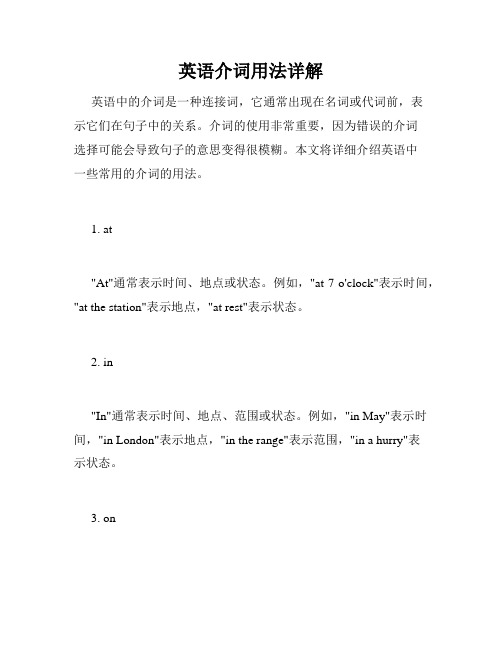
英语介词用法详解英语中的介词是一种连接词,它通常出现在名词或代词前,表示它们在句子中的关系。
介词的使用非常重要,因为错误的介词选择可能会导致句子的意思变得很模糊。
本文将详细介绍英语中一些常用的介词的用法。
1. at"At"通常表示时间、地点或状态。
例如,"at 7 o'clock"表示时间,"at the station"表示地点,"at rest"表示状态。
2. in"In"通常表示时间、地点、范围或状态。
例如,"in May"表示时间,"in London"表示地点,"in the range"表示范围,"in a hurry"表示状态。
3. on"On"通常表示时间、地点、表面或状态。
例如,"on Monday"表示时间,"on the table"表示地点,"on the surface"表示表面,"on fire"表示状态。
4. to"To"通常表示方向、目的地或比较。
例如,"go to the park"表示方向,"fly to Paris"表示目的地,"superior to"表示比较。
5. with"With"通常表示伴随、带有或使用。
例如,"with a friend"表示伴随,"apple with a worm"表示带有,"write with a pen"表示使用。
6. from"From"通常表示出发地、来源或区别。
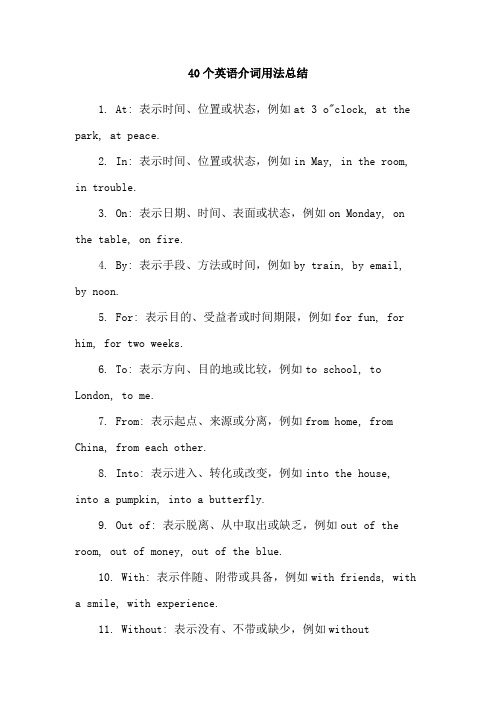
40个英语介词用法总结1. At: 表示时间、位置或状态,例如at 3 o"clock, at the park, at peace.2. In: 表示时间、位置或状态,例如in May, in the room, in trouble.3. On: 表示日期、时间、表面或状态,例如on Monday, on the table, on fire.4. By: 表示手段、方法或时间,例如by train, by email, by noon.5. For: 表示目的、受益者或时间期限,例如for fun, for him, for two weeks.6. To: 表示方向、目的地或比较,例如to school, to London, to me.7. From: 表示起点、来源或分离,例如from home, from China, from each other.8. Into: 表示进入、转化或改变,例如into the house,into a pumpkin, into a butterfly.9. Out of: 表示脱离、从中取出或缺乏,例如out of the room, out of money, out of the blue.10. With: 表示伴随、附带或具备,例如with friends, witha smile, with experience.11. Without: 表示没有、不带或缺少,例如withoutpermission, without shoes, without doubt.12. Over: 表示覆盖、超过或结束,例如over the roof, over the limit, over and done with.13. Under: 表示在下面、被支配或不足,例如under the table, under his control, under budget.14. About: 表示关于、大约或忙于,例如about the movie, about 10 dollars, about to leave.15. Above: 表示在上面、高于或超过,例如above the clouds, above average, above suspicion.16. Below: 表示在下面、低于或不足,例如below the surface, below freezing, below par.17. Across: 表示横穿、相交或涉及,例如across the street, across the board, across his mind.18. Beyond: 表示超出、远离或除了,例如beyond repair, beyond belief, beyond her control.19. Around: 表示周围、附近或环绕,例如around the corner, around the clock, around the world.20. Before: 表示以前、在前面或比较,例如before noon, before the house, before his time.21. Behind: 表示在后面、落后或背后,例如behind the house, behind schedule, behind the scenes.22. Beside: 表示在旁边、与...相比或附加,例如besidethe river, beside myself, beside the point.23. Inside: 表示内部、在里面或被包含,例如inside the box, inside the building, inside information.24. Outside: 表示外部、在外面或超出,例如outside the house, outside the box, outside the norm.25. Through: 表示穿过、经过或完成,例如through the door, through the park, through with it.26. Throughout: 表示遍布、贯穿或在整个期间,例如throughout the city, throughout history, throughout the day.27. Towards: 表示朝向、对于或接近,例如towards the sun, towards him, towards the end.28. Against: 表示反对、抵抗或紧挨着,例如against the law, against the current, against the wall.29. Among: 表示在...之中、相互之间或被分配到,例如among friends, among the stars, among the winners.30. Between: 表示在两者之间、在中间或相互之间,例如between two trees, between classes, between you and me.31. Within: 表示在内部、在范围之内或在规定时间内,例如within the house, within the budget, within a week.32. Without: 表示在外面、没有或不用,例如without the room, without a doubt, without further ado.33. Beneath: 表示在下面、低于或不足,例如beneath the surface, beneath his dignity, beneath contempt.34. Beside: 表示在旁边、与...相比或附加,例如beside the river, beside myself, beside the point.35. Into: 表示进入、转化或改变,例如into the house, into a pumpkin, into a butterfly.36. Upon: 表示在...之上、一旦发生或基于,例如upon the hill, upon arrival, upon further consideration.37. With: 表示伴随、附带或具备,例如with friends, witha smile, with experience.38. Within: 表示在内部、在范围之内或在规定时间内,例如within the house, within the budget, within a week.39. Without: 表示没有、不带或缺少,例如without permission, without shoes, without doubt.40. Beneath: 表示在下面、低于或不足,例如beneath the surface, beneath his dignity, beneath contempt.。
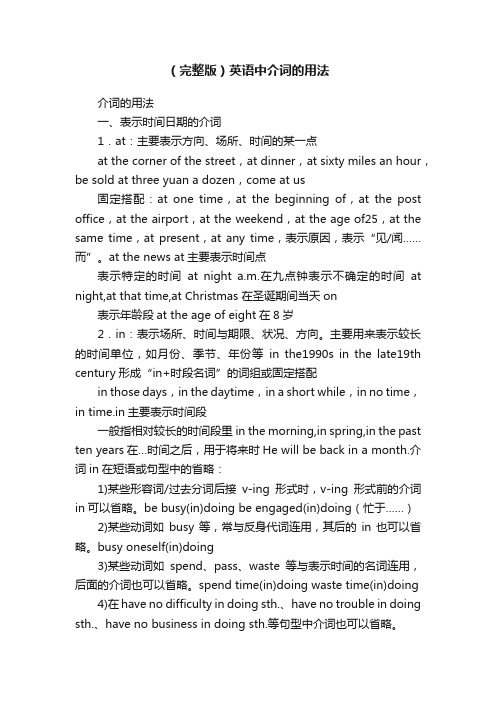
(完整版)英语中介词的用法介词的用法一、表示时间日期的介词1.at:主要表示方向、场所、时间的某一点at the corner of the street,at dinner,at sixty miles an hour,be sold at three yuan a dozen,come at us固定搭配:at one time,at the beginning of,at the post office,at the airport,at the weekend,at the age of25,at the same time,at present,at any time,表示原因,表示“见/闻……而”。
at the news at主要表示时间点表示特定的时间at night a.m.在九点钟表示不确定的时间at night,at that time,at Christmas 在圣诞期间当天on表示年龄段at the age of eight在8岁2.in:表示场所、时间与期限、状况、方向。
主要用来表示较长的时间单位,如月份、季节、年份等in the1990s in the late19th century形成“in+时段名词”的词组或固定搭配in those days,in the daytime,in a short while,in no time,in time.in主要表示时间段一般指相对较长的时间段里in the morning,in spring,in the past ten years在…时间之后,用于将来时He will be back in a month.介词in在短语或句型中的省略:1)某些形容词/过去分词后接v-ing形式时,v-ing形式前的介词in可以省略。
be busy(in)doing be engaged(in)doing(忙于……)2)某些动词如busy等,常与反身代词连用,其后的in也可以省略。

介词的常见用法介词是一个常见的词类,用于在句子中连接名词、代词、动词或其他词类,表示它们之间的关系。
介词的使用非常灵活多样,本文将重点介绍介词的常见用法,并提供一些例句来帮助读者更好地理解。
一、表示位置关系的介词1. in:表示在某个范围或物体内部。
例如:She is reading a book in the library.她正在图书馆读书。
2. on:表示在某个表面或物体的上方。
例如:The book is on the table.书在桌子上。
3. at:表示在某个地点或事件发生的地方。
例如:We will meet at the park tomorrow.我们明天在公园见面。
二、表示时间关系的介词1. at:表示具体的时刻或某个时间点。
例如:She will arrive at 8 o'clock.她将在8点钟到达。
2. on:表示具体的某一天或某个特定的日期。
例如:We have a meeting on Monday.我们星期一有个会议。
3. in:表示在某个时间段或某个月、季节、年份。
例如:He was born in 1990.他出生在1990年。
三、表示原因、目的、方式的介词1. for:表示目的或原因。
例如:She bought a gift for her friend.她给她的朋友买了一份礼物。
2. to:表示目的或方向。
例如:We went to the park to have a picnic.我们去公园野餐。
3. by:表示方式或方法。
例如:He goes to work by bike.他骑自行车上班。
四、表示从属关系、比较关系的介词1. of:表示从属关系或所属关系。
例如:The color of the car is red.这辆车的颜色是红色。
2. from:表示来源或出处。
例如:I received a letter from my friend.我收到了一封来自朋友的信。
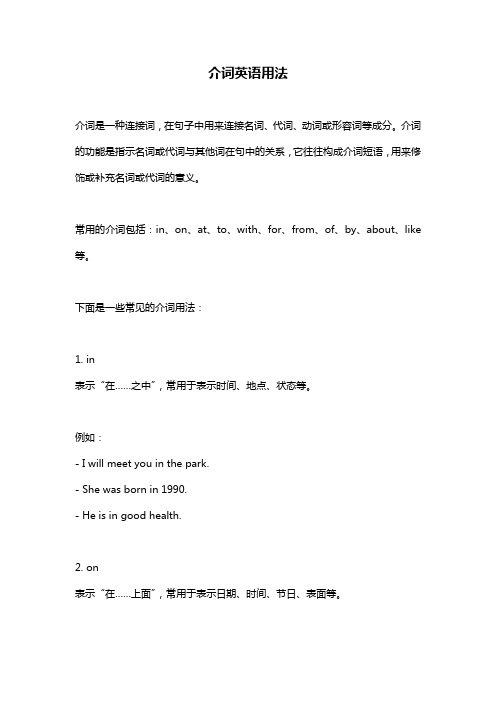
介词英语用法介词是一种连接词,在句子中用来连接名词、代词、动词或形容词等成分。
介词的功能是指示名词或代词与其他词在句中的关系,它往往构成介词短语,用来修饰或补充名词或代词的意义。
常用的介词包括:in、on、at、to、with、for、from、of、by、about、like 等。
下面是一些常见的介词用法:1. in表示“在……之中”,常用于表示时间、地点、状态等。
例如:- I will meet you in the park.- She was born in 1990.- He is in good health.2. on表示“在……上面”,常用于表示日期、时间、节日、表面等。
例如:- The book is on the table.- We will have a party on Christmas Day.- I usually go to bed on time.3. at表示“在……的地点、时间或情况”,常用于表示时间、地点、活动等。
例如:- We will meet at the station at 7 o'clock.- He is good at playing basketball.- I am at home now.4. to表示“到达”,常用于表示动作的方向。
例如:- I am going to the store.- He went to the park to play basketball.- She is walking to the school.5. with表示“带有……”,常用于表示伴随、附带等。
例如:- I went to the movies with my friends.- She is wearing a dress with flowers on it.- He plays the guitar with great skill.6. for表示“为了……”,常用于表示目的、原因、价值等。

英语介词用法大全一、介词preposition缩写prep,又叫前置词,表示其后的名词或代词(或是相当于名词的其他短语或从句)与其他句子成分的关系。
介词是一种虚词,不能单独在句中作成分。
二. 常用介词用法区分:1、in, on, to表示地理位置:in表示在某范围内,on指与什么毗邻,to指在某环境范围之外;2、on, in表示“在…上”时:on只表示在某物的表面上,in表示占去某物一部分;3、through, across都表示“穿过”时:through表示从内部通过,与in有关,across表示在表面上通过,与on有关;4、since, from表示表示时间时:since 指从过去到现在的一段时间,和完成时连用,from指从时间的某一点开始;5、in, on, at表示时间时:at表示片刻的时间,in表示一段的时间,on总是与日子有关;6、in, after表示时间时:in指在一段时间之后,after表示某一具体时间点之后或用在过去时的一段时间中;7、about, on表示“关于”时:about指涉及到,on指专门论述;8、besides与except表示“除了”:besides指“除了…还有再加上”,except指“除了,减去什么”,不放在句首;9、between与among表示“在两者之间”:between表示在两者之间,among用于三者或三者以上的中间;10、in, with表示“用”时:with表示具体的工具,in表示材料,方式,方法,度量,单位,语言,声音;11、in与into表示在里面:in通常表示位置(静态),into表示动向,不表示目的地或位置。
12、as与like:as意为“作为,以…地位或身份”,like为“象…一样”,指情形相似;三、介词用法口诀1、年月周前要用in,遇到几号用on,上午下午又是in.要说某日上下午,on换成in,午夜黄昏用at,黎明用它也不借。
at也在时分前,说“差”要用to,说“过”用part。

英语中介词的意思及用法英语中介词是冠词、代词、数词、动词等做状语、定语、表语等作用时,连接他们的词语。
在英语中,介词绝大多数都有主语和宾语,表示主语和宾语之间的一种关系。
英语中介词分为常用介词和少用介词。
一、常用介词常用介词有in, on, at, from, to, with, for, of, in front of, behind, under, over, above, below, along, between, among, before, after, through, across, during, beside, by等。
1、inin表示“在...之内”的意思,表示物体的物理位置,或者表示状态,或者表示某一段时间之内。
例如:The book is in the classroom. 书在教室里。
She was in the hospital last week.上星期在医院里。
2、onon表示“在...上面”的意思,一般表示物体的物理位置,或者某处正在进行的活动。
例如:The book is on the table. 书在桌子上。
They are having a meeting on the fourth floor. 他们正在四楼开会。
3、atat表示“在...旁边”的意思,表示物体的物理位置。
例如:The girl is at the window.孩在窗户旁边。
4、fromfrom表示“从...起”的意思,表示某处的起始点。
例如:She comes from China.来自中国。
5、toto表示“至...终点”的意思,表示某处的终点。
例如:He is going to the station. 他正去车站。
6、withwith表示“和...一起”的意思,一般表示一起行动或一起出现的情况,也可以表示和某人有某种特定的关系。
例如:The children are playing with their teacher.子们和老师一起玩。
英语常用介词用法与辨析
■表示方位的介词:in, to, on
1. in 表示在某地范围之内。
如:
Shanghai is/lies in the east of China. 上海在中国的东部。
2. to 表示在某地范围之外。
如:
Japan is/lies to the east of China. 日本位于中国的东面。
3. on 表示与某地相邻或接壤。
如:
Mongolia is/lies on the north of China. 蒙古国位于中国北边。
■表示计量的介词:at, for, by
1. at表示“以……速度”“以……价格”。
如:
It flies at about 900 kilometers a hour. 它以每小时900公里的速度飞行。
I sold my car at a high price. 我以高价出售了我的汽车。
2. for表示“用……交换,以……为代价”。
如:
He sold his car for 500 dollars. 他以五百元把车卖了。
注意:at表示单价(price) ,for表示总钱数。
3. by表示“以……计”,后跟度量单位。
如:
They paid him by the month. 他们按月给他计酬。
Here eggs are sold by weight. 在这里鸡蛋是按重量卖的。
■表示材料的介词:of, from, in
1. of成品仍可看出原料。
如:
This box is made of paper. 这个盒子是纸做的。
2. from成品已看不出原料。
如:
Wine is made from grapes. 葡萄酒是葡萄酿成的。
3. in表示用某种材料或语言。
如:
Please fill in the form in pencil first. 请先用铅笔填写这个表格。
They talk in English. 他们用英语交谈(from )。
注意:in指用材料,不用冠词;而with指用工具,要用冠词。
请比较:draw in pencil /draw with a pencil。
■表示工具或手段的介词:by, with, on
1. by用某种方式,多用于交通。
如by bus乘公共汽车,by e-mail. 通过电子邮件。
注意:表示搭乘交通工具时,用by时不用冠词,用in时要用冠词。
请比较:
I went there by bus/in a bus. 我是坐公共汽车去的那儿。
2. with表示“用某种工具”。
如:
He broke the window with a stone. 他用石头把玻璃砸坏了。
注意:with表示用某种工具时,必须用冠词或物主代词。
3. on表示“以……方式”,多用于固定词组。
They talked on the telephone. 他们通过电话进行交谈。
She learns English on the radio/on TV. 她通过收音机/电视学英语。
■表示关于的介词:of, about, on
1. of仅是提到或谈到过某人或某事。
如:
He spoke of the film the other day. 他前几天提到了这部影片。
He thought about this matter yesterday. 他昨天考虑了这件事。
2. about指“关于”某人或某事物的较详细的情况。
如:
Can you tell me something about yourself? 你能告诉我一些关于你自己的事情吗?
3. on指“关于”学术性的或严肃的事。
如:
It’s a textbook on the history of china. 它是一本有关中国历史的教科书。
■表原因或理由的介词:for, at, from, of, with, by, because of
1. for表示原因,常与sorry, famous, punish, praise, thank, blame等词连用。
如:
I am sorry for what I said to you. 我后悔不该对你讲那些话。
2. at指情感变化的原因,意为“因听到或看到而……”。
如:
He was surprised at the news. 听到这消息他大吃一惊。
3. from指“外在的原因”,如受伤、车祸等。
如:
He died from the wound. 他因受伤而致死。
4. of指“内在的原因”,如病、饿等。
如:
The old man died of hunger. 老人死于饥饿。
5. with指生理上或情感上的由外界到内心的原因。
如:
Hearing the news, he jumped with joy. 他们听到这个消息,欣喜若狂。
He was shaking with anger. 他气得浑身发抖。
6. by表示外部的,尤其是暴力的或无意中造成某种结果的原因。
Her body was bent by age. 他因年老背弯了。
She took your umbrella by mistake. 我因弄错拿了你的雨伞。
7. because of 表示引起结果的直接原因。
如:
He retired last month because of illness/because he ill.
8. owing to多表示引起某不良后果的原因。
如:
Owing to the rain they could not come. 由于下雨他们没来。
9. thanks to表示引起某种幸运结果的原因,常译为“幸亏……,多亏……”。
如:
Thanks to John, we won the game. 多亏约翰,我们才赢了这场比赛。
10. out of表示动机的起因,常译为“出于……”。
如:
He asked the question out of curiosity. 他出于好奇才问了那个问题。
11. through多表示因局部而影响全局的原因。
如:
The war was lost through bad organization. 战争因组织不周而失败了。
■表示好像或当作的介词:like, as
1. like表示“像……一样”,其实不是。
如:
Peter the Great, like his country, was strong and proud. 彼得大帝像他的国家一样强健和自豪。
2. as表示“作为,以……身份”,其实也是。
如:
He talked to me as a father. 他以父亲的身份跟我谈话。
注:as作连词时,可表示“好像……”。
如:The work is not so difficult as you ima gin这工作不像你想像的那么困难。
■表示支持或反对的介词:against, for
against反对,for支持,互为反义词。
如:
Are you for my idea or against it? 你赞同还是反对我的想法?
■表示除某人某物外的介词:besides, except
1. besides是包括后面所提人或物在内的“除……外,还”。
如:
Thirty students went to the cinema besides him. 除他以外,还有30个学生去看了电影。
(他和另外30人都去了)
He is interested in tennis besides(=as well as)football. 除了足球,他还对网球感兴趣。
2. except是指不包括后面所提人或物在内的“除去”。
如(from ):
Everyone is excited except me. 除我以外的每个人都很激动。
(他们激动,而我却不激动)
All the visitors are Japanese except him. 除他以外的所有游客都是日本人。
(其他人是日本人,可他不是)
注意:(A) except通常与表示全体的all, every连用;若与other连用,只能用besides。
如:He had other people to take care of besides me. 除我之外,他还要照顾别人。
(B) except是排除同类;而except for是排除非同类,常在说明基本情况后,从细节上加上修正。
如:
The composition is very good except for a few spelling mistakes. 除了几处拼写错误之外,这篇作文整体还是不错的。
(作文与拼写错误是非同类的)
但except for也可代替except,特别是在句首时,因为except是不能用于句首的。
如:Except George, you can all go. 除乔治外,你们都可以去。